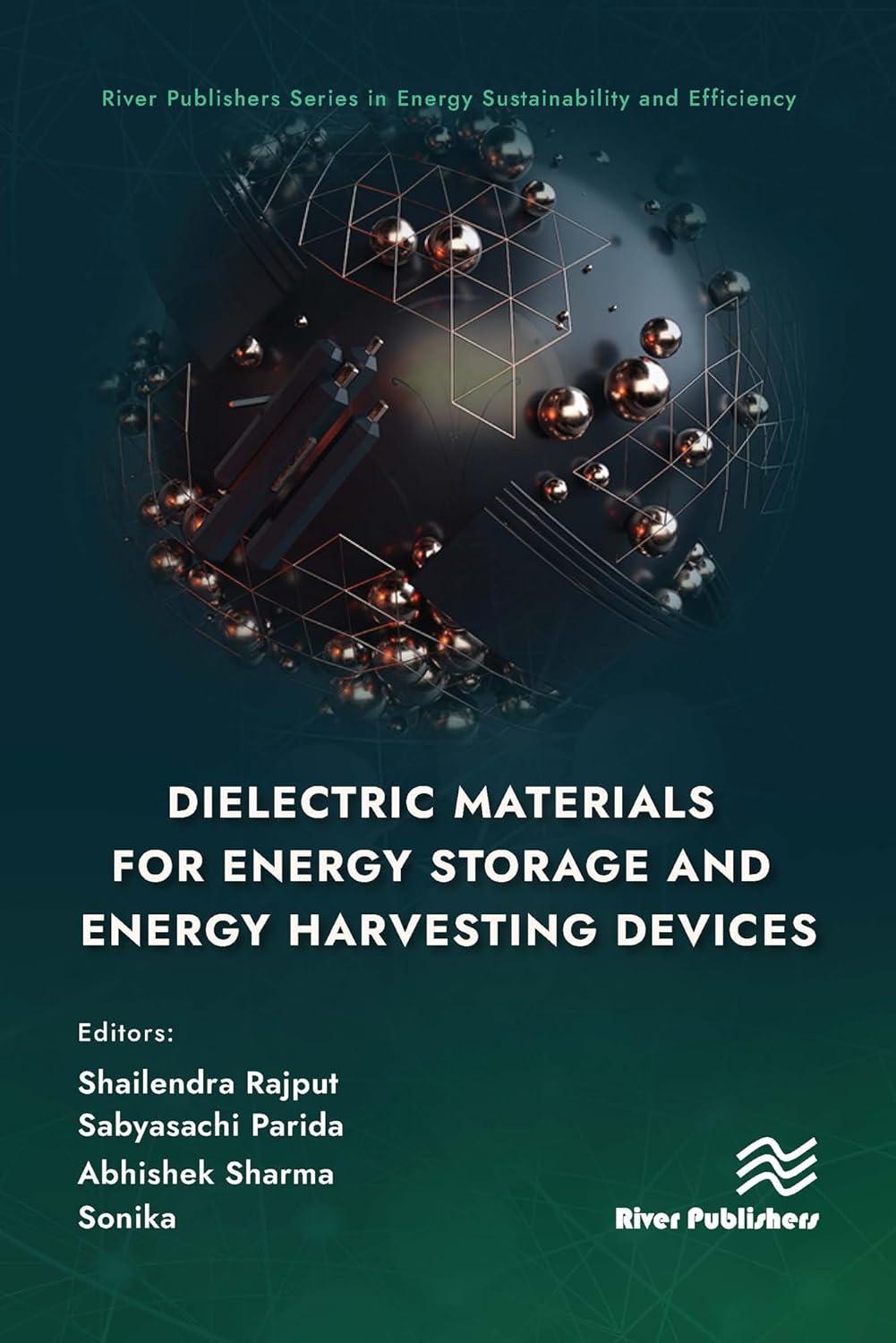StorageDevicesforRenewableEnergy-Based Systems:RechargeableBatteriesand Supercapacitors2ndEditionNihalKularatna
https://ebookmass.com/product/energy-storage-devices-forrenewable-energy-based-systems-rechargeable-batteries-andsupercapacitors-2nd-edition-nihal-kularatna/
Instant digital products (PDF, ePub, MOBI) ready for you
Download now and discover formats that fit your needs...
Dielectric Materials for Energy Storage and Energy Harvesting Devices Shailendra Rajput & Sabyasachi Parida & Abhishek Sharma & Sonika
https://ebookmass.com/product/dielectric-materials-for-energy-storageand-energy-harvesting-devices-shailendra-rajput-sabyasachi-paridaabhishek-sharma-sonika/ ebookmass.com
Nanowire Energy Storage Devices: Synthesis, Characterization and Applications Liqiang Mai
https://ebookmass.com/product/nanowire-energy-storage-devicessynthesis-characterization-and-applications-liqiang-mai/
ebookmass.com
Energy Storage Systems: System Design and Storage Technologies Armin U. Schmiegel
https://ebookmass.com/product/energy-storage-systems-system-designand-storage-technologies-armin-u-schmiegel/
ebookmass.com
The Final Curtain (The Kyoichiro Kaga Series #4) Keigo Higashino
https://ebookmass.com/product/the-final-curtain-the-kyoichiro-kagaseries-4-keigo-higashino/
ebookmass.com
Spectres of John Ball: The Peasants' Revolt in English Political History, 1381-2020 James Crossley
https://ebookmass.com/product/spectres-of-john-ball-the-peasantsrevolt-in-english-political-history-1381-2020-james-crossley/
ebookmass.com
Industry 4.0 and Circular Economy: Towards a Wasteless Future or a Wasteful Planet? Antonis Mavropoulos
https://ebookmass.com/product/industry-4-0-and-circular-economytowards-a-wasteless-future-or-a-wasteful-planet-antonis-mavropoulos/
ebookmass.com
Protected by Outcasts: Steamy Rejected Fated Mates Reverse Harem (Rejected Wolf Pack Book 1) Traci Lovelot
https://ebookmass.com/product/protected-by-outcasts-steamy-rejectedfated-mates-reverse-harem-rejected-wolf-pack-book-1-traci-lovelot/
ebookmass.com
Data, Statistics, and Useful Numbers for Environmental Sustainability: Bringing the Numbers to Life 1st Edition
Benoit Cushman-Roisin
https://ebookmass.com/product/data-statistics-and-useful-numbers-forenvironmental-sustainability-bringing-the-numbers-to-life-1st-editionbenoit-cushman-roisin/
ebookmass.com
Nkrumaism and African Nationalism 1st ed. Edition Matteo
Grilli
https://ebookmass.com/product/nkrumaism-and-african-nationalism-1sted-edition-matteo-grilli/
ebookmass.com
The Grandmother Plot: A Novel Caroline B. Cooney
https://ebookmass.com/product/the-grandmother-plot-a-novel-caroline-bcooney/
ebookmass.com
Energy Storage Devices for Renewable Energy-Based Systems
Rechargeable Batteries and Supercapacitors
Second Edition
Nihal Kularatna
School of Engineering, University of Waikato, Hamilton, New
Zealand
Kosala Gunawardane
Department of Electrical and Electronic Engineering, Auckland
University of Technology, Auckland, New Zealand
Table of Contents
Cover image
Title page
Copyright About the authors
Preface Acknowledgments
1: Modern electrical power system and the role of distributed generation
Abstract
1.1: Evolution of electricity systems
1.2: Status of current power systems
1.3: Distributed generation
1.4: Renewable DG technologies
1.5: Energy storages technologies for distributed generation
1.6: Impact of distributed generation
1.7: Smart grid
1.8: DG penetration and evolving DC microgrids
2: Fundamentals of energy storage devices
Abstract 2.1: Introduction
2.2: Simple fundamentals
2.3: Energy storage in electrical systems
2.4: Compressed air energy storage
2.5: Superconductive magnetic energy storage
2.6: Rapid energy transfer requirements and fundamental circuit issues
2.7: Technical specifications of ESDs
2.8: Ragone plot
3: Rechargeable battery An electronic circuit designer’s viewpoint
Abstract
3.1: Introduction
3.2: Battery terminology and fundamentals
3.3: Battery technologies: An overview
3.4: Lead-acid batteries
3.5: Nickel-cadmium batteries
3.6: Nickel metal hydride batteries
3.7: Lithium-based rechargeable batteries
3.8: Reusable alkaline batteries
3.9: Zn-air batteries
3.10: Rechargeable batteries versus supercapacitors
4: Dynamics, models, and management of rechargeable batteries Abstract
4.1: Introduction
4.2: Simplest concept of a battery
4.3: Battery dynamics
4.4: Electrochemical impedance spectroscopy for batteries
4.5: Battery equivalent circuit models and modeling techniques
4.6: Battery management in practical applications
4.7: Prognostics in battery health management
4.8: Fast charging of batteries
4.9: Battery communication and related standards
4.10: Battery safety
4.11: Future
5: Recent developments of high-performance battery systems
Abstract
5.1: Introduction
5.2: Flow batteries for renewable energy systems
5.3: Solid-state batteries
5.4: More recent advances of traditional rechargeable batteries
6: Capacitors as energy storage devices: Simple basics to current commercial families
Abstract
6.1: Capacitor fundamentals
6.2: Capacitor characteristics
6.3: Capacitor application scope
6.4: Capacitor types
6.5: Capacitor aging, lifetime, and reliability
7: Electrical double-layer capacitors
Abstract
7.1: Introduction
7.2: Historical background
7.3: Electrical double-layer effect and device construction
7.4: Pseudocapacitance and pseudocapacitors
7.5: Hybridization of electrochemical capacitors and rechargeable batteries
7.6: Modeling and equivalent circuits
7.7: Testing of devices and characterization
7.8: Modules and voltage balancing
8: New developments of larger supercapacitors: Symmetrical devices, hybrid types, and battery-capacitors
Abstract
8.1: Introduction
8.2: Supercapacitor modules
8.3: Recent advances in supercapacitor technologies and commercial devices
8.4: Comparison of discharge curves of different supercapacitor families
8.5: Future developments of larger supercapacitors
9: Supercapacitor assisted (SCA) techniques and the supercapacitor-assisted loss management (SCALoM) concept
Abstract
9.1: Introduction
9.2: Typical capacitor charging and discharging process
9.3: Generalized case of the RC circuit; with precharged capacitor connected to a DC source, which is higher than the rated DC voltage of the capacitor
9.4: Analysis of discharging efficiency
9.5: Supercapacitor as a lossless dropper
9.6: The first useful application: SC as a lossless dropper in SCALDO
9.7: Resistor-loss and capacitor energy capability in SCASA technique and issues of direct implementation
9.8: Basis of SCATMA technique
9.9: Renewable energy areas and SCALED basics
9.10: Potential future applications
9.11: Conclusion
10: Supercapacitor as a lossless dropper in DC-DC converters— SCALDO technique
Abstract
10.1: Introduction
10.2: DC-DC converters and DC power management
10.3: Supercapacitor-assisted low-dropout regulator (SCALDO) technique
10.4: Generalized SCALDO concept
10.5: Practical examples
10.6: SCALDO implementation examples
10.7: Wider applications of SCALDO technique
10.8: Comparison between SCALDO regulators and charge pumps
11: Extended applications of SCALDO technique
Abstract
11.1: Introduction
11.2: RS-SCALDO technique
11.3: DC-UPS SCALDO regulators
11.4: Dual-polarity (DO-SCALDO) concept
12: Supercapacitor-assisted LED lighting technique and its applications in DC microgrids
Abstract
12.1: Introduction to different lighting systems
12.2: DC operation of LED units: 12 V and higher voltage DC operable flood lighting units
12.3: Supercapacitors (SCs) for short-term DC-UPS capability to overcome solar energy fluctuations
12.4: Replacing battery banks with supercapacitors: Issue of MPPT implementation
12.5: SCALED topology and its theory related to higher-efficiency LED lighting
12.6: An overview of pilot project
13: Supercapacitors for surge absorption: Supercapacitor assisted surge absorber (SCASA) technique
Abstract
13.1: Introduction
13.2: Lightning and inductive energy dumps in electric circuits and typical surge absorber techniques
13.3: Supercapacitor as a surge absorption device: Summarized results of a preliminary investigation
13.4: Design approaches to a supercapacitor-based surge protector
13.5: Conclusion
14: Supercapacitors in a rapid heat transfer application
Abstract
14.1: Introduction
14.2: Problem of wasted water in day-to-day situations at home
14.3: Problem of traditional heating from direct AC mains supply and heating system specifications
14.4: Commercial solutions for eliminating water wastage due to storage in buried plumbing
14.5: Practical requirements for a localized solution
14.6: SC-based solution with prestored energy
14.7: Results from an ongoing prototype development exercise
14.8: Specific advantages of SC energy storage
14.9: Implementation challenges
14.10: Recent developments of commercial supercapacitor families and their impact on this technique
Appendix: Capacitors and AC line filtering
Index
Copyright
Academic Press is an imprint of Elsevier
125 London Wall, London EC2Y 5AS, United Kingdom
525 B Street, Suite 1650, San Diego, CA 92101, United States
50 Hampshire Street, 5th Floor, Cambridge, MA 02139, United States
The Boulevard, Langford Lane, Kidlington, Oxford OX5 1GB, United
Kingdom Copyright © 2021 Elsevier Inc. All rights reserved.
No part of this publication may be reproduced or transmitted in any form or by any means, electronic or mechanical, including photocopying, recording, or any information storage and retrieval system, without permission in writing from the publisher. Details on how to seek permission, further information about the Publisher’s permissions policies and our arrangements with organizations such as the Copyright Clearance Center and the Copyright Licensing Agency, can be found at our website:
This book and the individual contributions contained in it are protected under copyright by the Publisher (other than as may be noted herein).
Notices
Knowledge and best practice in this field are constantly changing. As new research and experience broaden our understanding, changes in research methods, professional practices, or medical treatment may become necessary.
Practitioners and researchers must always rely on their own experience and knowledge in evaluating and using any information, methods, compounds, or experiments described herein. In using such information or methods they should be mindful of their own safety and the safety of others, including parties for whom they have a professional responsibility.
To the fullest extent of the law, neither the Publisher nor the authors, contributors, or editors, assume any liability for any injury and/or damage to persons or property as a matter of products liability, negligence or otherwise, or from any use or operation of any methods, products, instructions, or ideas contained in the material herein.
A catalog record for this book is available from the Library of Congress
British Library Cataloguing-in-Publication Data
A catalogue record for this book is available from the British Library
ISBN 978-0-12-820778-9
For information on all Academic Press publications visit our website at https://www.elsevier.com/books-and-journals
Publisher: Brian Romer
Acquisitions Editor: Lisa Reading
Editorial Project Manager: Aleksandra Packowska
Production Project Manager: Prem Kumar Kaliamoorthi
Cover Designer: Victoria Pearson















